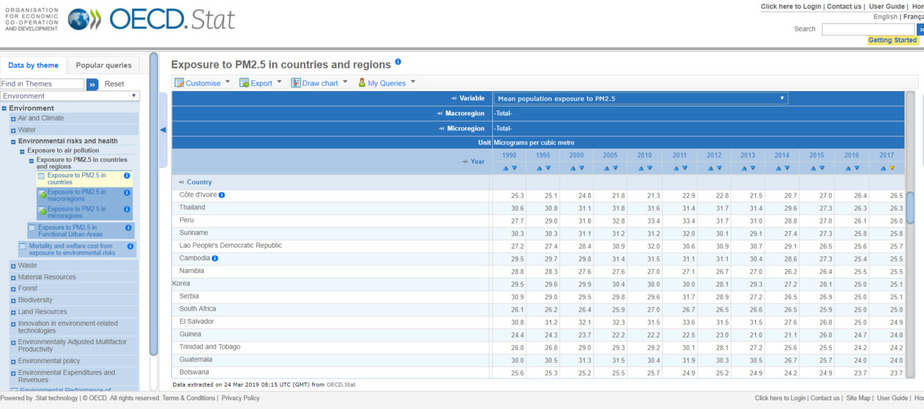Posted on : Mar.25,2019 18:01 KST
 |
|
A day of heavy fine-dust pollution in Seoul (Hankyoreh archives)
|
OECD website places South Korea at 74th place out of 190, tying with Serbia
South Korean ranks as one of the five worst countries in the world for air quality. So what accounts for its high percentage of coal-based electricity prediction?
On the morning of Mar. 24, Yonhap News published an article titled “South Korea one of five worst for air [. . .] also ranks among lowest for percentage of coal-based electricity.” Citing energy industry and OECD figures, it noted that South Korea’s air quality index of 25.1 for PM2.5 dust (particles measuring 2.5㎛ and smaller) ranked it among the five worst in the world alongside India (90.2), China (53.5), Vietnam (30.3) and South Africa (25.0), adding that improvement would be difficult because of the high percentage of coal-based power generation. Coming at a time of intense interest in fine particle pollution, the article drew major attention, receiving over 4,000 replies when posted on the portal site Naver and reprinted in over 30 different news outlets. But is it actually true?
 |
|
PM 2.5-based air quality statistics for different countries in 2017 as posted on the OECD website
|
According to PM 2.5-based air quality statistics for different countries in 2017 as posted on the OECD website, South Korea tied with Serbia for 74th place among over 190 countries examined. The country with the world’s worst air quality was not India but Nepal (99.9), followed by Niger (94.1) and Saudi Arabia (92.4). Many Middle Eastern and African countries were ranked in between India and China (19th), including Qatar, Egypt and Cameroon. Vietnam ranked 59th rather than in the bottom five; South Africa came after South Korea in 76th place. Japan, the US, and European countries had relatively good air quality figures, falling outside the worst 100.
The figures on coal-based power generation, which was fingered as a cause for the poor quality, also differed from Korea Electric Power Corporation (KEPCO) numbers. According to the report, South Korea depended on coal energy for 46.2% of all electricity generated in 2017; KEPCO, which is in charge of domestic electricity production, gave a somewhat lower figure of 43.1%. The Yonhap report appeared to be referencing the “BP Statistical Review of World Energy” published last June by British petroleum company BP.
While the reports of a continued increase in coal-based power plants in South Korea and China were accurate, the prediction that air quality is unlikely to improve was more or less speculative. According to the South Korean government’s eighth framework plan for electricity supplies, coal-based electricity prediction is poised to increase from 36.9GW in 2017 to 42GW in 2022, but then decline to 39.9GW by 2030. Even if coal-based power does increase, fine dust emissions could be reduced through increased environmental investments. According to Ministry of Environment figures, the volume of fine dust produced through coal-fired power generation has steadily declined from 36,300 tons in 2015 to 28,700 in 2017 and 24,900 in 2018. The percentage of coal-fired energy out of all power generation facilities is also predicted to decline from 31.6% in 2017 to 29.5% in 2022 and 23% in 2030.
By Choi Hyun-june and Choi Ha-yan, staff reporters
Please direct comments or questions to [english@hani.co.kr]










